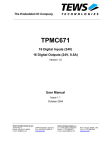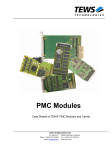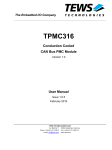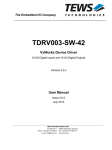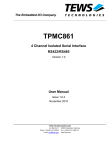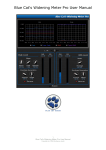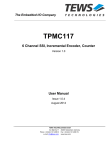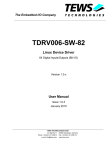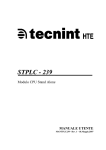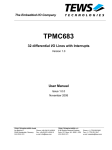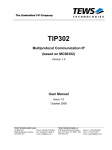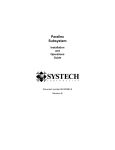Download User Manual TPMC670
Transcript
The Embedded I/O Company TPMC670 16/8 Digital Inputs (24V) 16/8 Digital Outputs (24V, 0.5A) Version 3.0 User Manual Issue 3.0.0 June 2014 TEWS TECHNOLOGIES GmbH Am Bahnhof 7 25469 Halstenbek, Germany Phone: +49 (0) 4101 4058 0 Fax: +49 (0) 4101 4058 19 e-mail: [email protected] www.tews.com TPMC670-10R 16 digital inputs, 16 digital outputs front panel I/O TPMC670-11R 8 digital inputs, 8 digital outputs This document contains information, which is proprietary to TEWS TECHNOLOGIES GmbH. Any reproduction without written permission is forbidden. TEWS TECHNOLOGIES GmbH has made any effort to ensure that this manual is accurate and complete. However TEWS TECHNOLOGIES GmbH reserves the right to change the product described in this document at any time without notice. front panel I/O TPMC670-20R TEWS TECHNOLOGIES GmbH is not liable for any damage arising out of the application or use of the device described herein. 16 digital inputs, 16 digital outputs Style Conventions P14 I/O Hexadecimal characters are specified with prefix 0x, i.e. 0x029E (that means hexadecimal value 029E). TPMC670-21R For signals on hardware products, an ‘Active Low’ is represented by the signal name with # following, i.e. IP_RESET#. 8 digital inputs, 8 digital outputs P14 I/O Access terms are described as: W Write Only R Read Only R/W Read/Write R/C Read/Clear R/S Read/Set 2014 by TEWS TECHNOLOGIES GmbH All trademarks mentioned are property of their respective owners. TPMC670 User Manual Issue 3.0.0 Page 2 of 29 Issue Description Date 1.0 First Issue January 1999 1.1 Addition Target Chip description June 1999 1.2 New Hardware Version November 2002 1.3 Addition “Technical Specification” April 2003 1.4 Correction “PCI Configuration Register” September 2003 1.5 Correction Block Diagram September 2004 1.6 New address TEWS LLC September 2006 1.7 Correction Functional Description of Control / Status Register June 2008 2.0.0 New User Manual Issue Notation September 2010 3.0.0 New Board Version June 2014 TPMC670 User Manual Issue 3.0.0 Page 3 of 29 Table of Contents 1 2 3 PRODUCT DESCRIPTION ......................................................................................... 6 TECHNICAL SPECIFICATION ................................................................................... 7 FUNCTIONAL DESCRIPTION ................................................................................... 8 3.1 Digital Outputs ................................................................................................................................ 8 3.1.1 Optical Isolation..................................................................................................................... 8 3.1.2 Output Polarity ...................................................................................................................... 8 3.1.3 Overload Protection .............................................................................................................. 8 3.1.4 Output Watchdog .................................................................................................................. 9 3.2 Digital Inputs ................................................................................................................................... 9 3.2.1 Optical Isolation..................................................................................................................... 9 3.2.2 Debounce Function ............................................................................................................. 10 3.2.3 Interrupt Logic ..................................................................................................................... 10 4 ADDRESS MAP ........................................................................................................ 11 4.1 4.2 4.3 4.4 5 PCI Configuration Space .............................................................................................................. 11 Base Address Register Configuration ........................................................................................ 11 Configuration Register Space Address Map.............................................................................. 12 Local Register Space Address Map ............................................................................................ 12 REGISTER DESCRIPTION ...................................................................................... 13 5.1 Configuration Register Space ..................................................................................................... 13 5.1.1 Local Address Space 0 Bus Region Descriptor (LAS0BRD) .............................................. 13 5.1.1 Interrupt Control/Status (INTCSR) ...................................................................................... 13 5.1.1 Serial EEPROM and Initialization Control (CNTRL) ........................................................... 14 5.1.1 General Purpose I/O Control (GPIOC) ............................................................................... 15 5.1.1 Configuration Space Revision Register (CREVREG) ......................................................... 15 5.1 Local Register Space .................................................................................................................... 16 5.1.1 Data Output Register .......................................................................................................... 16 5.1.2 Data Input Register ............................................................................................................. 17 5.1.3 Control / Status Register ..................................................................................................... 18 5.1.4 Rising Edge Interrupt Enable Register ............................................................................... 19 5.1.5 Falling Edge Interrupt Enable Register ............................................................................... 20 5.1.6 Rising Edge Interrupt Status Register ................................................................................ 21 5.1.7 Falling Edge Interrupt Status Register ................................................................................ 22 5.1.8 Debounce Time Register .................................................................................................... 23 6 CONFIGURATION HINTS ........................................................................................ 25 6.1 Big / Little Endian .......................................................................................................................... 25 6.2 Local Software Reset .................................................................................................................... 25 6.3 Configuration EEPROM ................................................................................................................ 26 7 INSTALLATION TPMC670 ....................................................................................... 27 7.1 Input Wiring ................................................................................................................................... 27 7.2 Output Wiring ................................................................................................................................ 27 8 PIN ASSIGNMENT – I/O CONNECTOR .................................................................. 28 8.1 Front Panel I/O ............................................................................................................................... 28 8.2 Mezzanine Card Connector P14 .................................................................................................. 29 TPMC670 User Manual Issue 3.0.0 Page 4 of 29 List of Figures FIGURE 1-1 : BLOCK DIAGRAM ...................................................................................................................... 6 FIGURE 5-1: FORMULAS TO DETERMINE PRELOAD VALUE ................................................................... 23 FIGURE 7-1 : INPUT WIRING......................................................................................................................... 27 FIGURE 7-2 : OUTPUT WIRING .................................................................................................................... 27 List of Tables TABLE 2-1 : TECHNICAL SPECIFICATION ..................................................................................................... 7 TABLE 3-1 : ISOLATED DIGITAL OUTPUTS ................................................................................................... 8 TABLE 3-2 : ISOLATED DIGITAL INPUTS ....................................................................................................... 9 TABLE 4-1 : PCI CONFIGURATION SPACE HEADER ................................................................................. 11 TABLE 4-2 : BASE ADDRESS REGISTER CONFIGURATION ..................................................................... 11 TABLE 4-3 : CONFIGURATION REGISTER SPACE ADDRESS MAP .........................................................12 TABLE 4-4 : LOCAL REGISTER SPACE ADDRESS MAP ............................................................................ 12 TABLE 5-1 : LOCAL ADDRESS SPACE 0 BUS REGION DESCRIPTOR .....................................................13 TABLE 5-2 : INTERRUPT CONTROL/STATUS ............................................................................................. 13 TABLE 5-3 : SERIAL EEPROM AND INITIALIZATION CONTROL ............................................................... 14 TABLE 5-4 : GENERAL PURPOSE I/O CONTROL ....................................................................................... 15 TABLE 5-5 : CONFIGURATION SPACE REVISION REGISTER................................................................... 15 TABLE 5-6 : DATA OUTPUT REGISTER ....................................................................................................... 16 TABLE 5-7 : DATA INPUT REGISTER ........................................................................................................... 17 TABLE 5-8 : CONTROL / STATUS REGISTER.............................................................................................. 18 TABLE 5-9 : RISING EDGE INTERRUPT ENABLE REGISTER .................................................................... 19 TABLE 5-10: FALLING EDGE INTERRUPT ENABLE REGISTER ................................................................ 20 TABLE 5-11: RISING EDGE INTERRUPT STATUS REGISTER ................................................................... 21 TABLE 5-12: FALLING EDGE INTERRUPT STATUS REGISTER ................................................................ 22 TABLE 5-13: DEBOUNCE TIME REGISTER ................................................................................................. 23 TABLE 5-14: DEBOUNCE TIME / EXAMPLES .............................................................................................. 24 TABLE 6-1 : LOCAL BUS LITTLE/BIG ENDIAN ............................................................................................. 25 TABLE 6-2 : CONFIGURATION EEPROM TPMC670-XX .............................................................................. 26 TABLE 8-1 : PIN ASSIGNMENT I/O HD50 CONNECTOR............................................................................. 28 TABLE 8-2 : MEZZANINE CARD CONNECTOR P14 .................................................................................... 29 TPMC670 User Manual Issue 3.0.0 Page 5 of 29 1 Product Description The TPMC670 is a standard single-width 32 bit PMC with 16/8 24V digital inputs galvanically isolated from the computer system by optocouplers. The inputs are also potential free to each other in groups of four inputs. A high performance input circuit ensures a defined switching point and polarization protection against confusing the pole. All inputs have a common electronic debounce circuit with a freely programmable debounce time. All inputs can generate an interrupt. The signal edge handling is programmable to interrupt on rising, falling or both edges of the input signal. The TPMC670 has 16/8 digital high side switches with galvanic isolation from the computer system by optocouplers. The outputs are also isolated against each other in groups of four outputs. All outputs are protected against short-circuit and thermal overload. The output drivers are capable of driving 0.5A continuous per channel. A hardware watchdog clears all outputs in case of trigger fail. The TPMC670-1x provides front panel I/O, the TPMC670-2x provides P14 I/O. Figure 1-1 : Block Diagram TPMC670 User Manual Issue 3.0.0 Page 6 of 29 2 Technical Specification Mechanical Interface PCI Mezzanine Card (PMC) Interface, Single Size Electrical Interface PCI Rev. 3.0 compliant 33 MHz / 32 bit PCI 3.3 V and 5 V PCI Signaling Voltage On Board Devices PCI Target Chip and Local Control Logic MachXO2 (Lattice) I/O Interface Number of Inputs TPMC670-10R/-20R TPMC670-11R/-2R Input Isolation Optocouplers for galvanic isolation, also isolated to each other in groups of four inputs Input Voltage 24 V DC typical Input Current 4.2 mA typical at 24 V input voltage Input Switching Level 12 V typical, 7.5 V minimum, 14 V maximum Input Signal Debouncing Electronic debouncing ( 7 µs to 440 ms in steps of 7 µs ) common for all input channels, can be disabled Input Interrupts 16 / 8 input interrupts (Trigger on rising, falling or both edges) Number of Outputs TPMC670-10R/-20R TPMC670-11R/-21R Output Isolation Optocouplers for galvanic isolation, also isolated to each other in groups of four outputs External Output Voltage 24 V DC typical, 6 V DC minimum, 48 V DC maximum Output Current 0.5 A typical (0.3 A for voltages over 32 V) Short Circuit Current 0.8 A typical Output Voltage Drop 1.1 V typical at 0.5 A Output Protection Overload, short circuit, GND and Vs open wire protection, thermal shutdown I/O Connector TPMC670-10R/-20R HD50 connector – SCSI-2 type connector TPMC670-11R/-21R PMC P14 I/O (64 pin Mezzanine connector) 16 digital Inputs 8 digital Inputs 16 digital Outputs 8 digital Outputs Physical Data Power Requirements 25 mA typical @ +5 V DC with all inputs and outputs inactive 90 mA typical @ +5 V DC with all inputs and outputs active Temperature Range Operating Storage MTBF TPMC670-10R/-20R: 850.000 h TPMC670-11R/-21R: 979.000 h Humidity 5 – 95 % non-condensing Weight 70 g -25 °C to +85 °C -55 °C to +125 °C Table 2-1 : Technical Specification TPMC670 User Manual Issue 3.0.0 Page 7 of 29 3 Functional Description 3.1 Digital Outputs 3.1.1 Optical Isolation The TPMC670 has 16 (TPMC670-10/20) or 8 (TPMC670-11/21) digital outputs. The standard signal level for these outputs is 24 V DC. All outputs are isolated by optocouplers from the computer system and are also isolated against each other in groups of four outputs. GROUP VS / standard 24V DC GROUND OUTPUT O1 VS_O1 GND_O1 OUT 1 OUT 2 OUT 3 OUT 4 O2 VS_O GND_O2 OUT 5 OUT 6 OUT 7 OUT 8 O3 VS_O3 GND_O3 OUT 9 OUT 10 OUT 11 OUT 12 O4 VS_O4 GND_O4 OUT 13 OUT 14 OUT 15 OUT 16 Table 3-1 : Isolated Digital Outputs 3.1.2 Output Polarity Each output can be individually switched to the according power supply VS_Ox (high side switch). 3.1.3 Overload Protection The output drivers used on the TPMC670 are smart drivers TDE1707. The maximum continuous output current is 0.5 A. The output circuits are protected against overload, short circuit and over temperature. In case of such a failure the corresponding output is switched off until the error condition is removed. Then the output returns automatically to normal operation and the state programmed in the Data Output Register. For details about the protection of the TDE1707 please refer to the data sheet, available at http://www.st.com. TPMC670 User Manual Issue 3.0.0 Page 8 of 29 3.1.4 Output Watchdog Writing ‘1’ into bit 1 of the Global Control Register and the following first write access to the Data Output Register enables the hardware watchdog function. The status of the watchdog is indicated at the bit 3 of Global Control Register. Any software access (read or write) to the Data Output Register of the TPMC670 will retrigger the watchdog. The maximum time between two accesses is set to 120 ms, if the time expires without a software access all outputs go into the ‘OFF’ state. At the same time the watchdog status will change from ‘0’ to ‘1’ and lock the Data Output Register. This prevents a write access to the Data Output Register. Writing ‘1’ to the watchdog status (Bit 3 Control Register) clears this bit and also unlocks the Output Register. After unlocking the Data Output Register the outputs stay in the ‘OFF’ state till the next write access to this register. The watchdog is disabled after power-on or reset. 3.2 Digital Inputs 3.2.1 Optical Isolation The TPMC670 has 16 (TPMC670-10R/20R) or 8 (TPMC670-11R/21R) digital inputs. The standard signal level for these inputs is 24 V DC. The switching level of the inputs is between 7.5 V and 14 V. All inputs are isolated by optocouplers from the computer system and are also isolated against each other in groups of four inputs. GROUP GROUND INPUT I1 GND_I1 IN 1 IN 2 IN 3 IN 4 I2 GND_I2 IN 5 IN 6 IN 7 IN 8 I3 GND_I3 IN 9 IN 10 IN 11 IN 12 I4 GND_I4 IN 13 IN 14 IN 15 IN 16 Table 3-2 : Isolated Digital Inputs TPMC670 User Manual Issue 3.0.0 Page 9 of 29 3.2.2 Debounce Function A programmable debounce function common for all inputs is implemented on the TPMC670. There is only one debounce time adjustable for all 16 (TPMC670-10R/20R) or 8 (TPMC670-11R/21R) digital inputs. If the debounce function is enabled, the input pin must be static for the programmed debounce time before the rising or falling edge is recognized as valid. Thus, only after a correct identification the Data Input Register is updated and an interrupt is generated. The debounce function is disabled after power-on and reset. The debounce time is set to value ‘0’ after power-on and reset. 3.2.3 Interrupt Logic Interrupt generation can be individually programmed for each channel and input transition. To enable the interrupt after a reset, the Global Interrupt Enable bit in the Control Register must be set to the value ‘1’. Also the respective bit for rising or falling edge in the Rising Edge / Falling Edge Interrupt Enable Registers must be set. The Global Interrupt Enable and also all individually interrupt enable bits are disabled after power-on and reset. TPMC670 User Manual Issue 3.0.0 Page 10 of 29 4 Address Map 4.1 PCI Configuration Space PCI CFG Register Address Write ‘0’ to all unused (Reserved) bits 31 24 23 16 15 Initial Values (Hex Values) 8 7 0 0x00 Device ID Vendor ID 9050 10B5 0x04 Status Command 0280 0000 0x08 0x0C Class Code not supported Header Type PCI Latency Timer Revision ID 118000 00 Cache Line Size 00 00 00 00 0x10 Base Address Register 0 (BAR0) FFFFFF80 0x14 Base Address Register 1 (BAR1) FFFFFF81 0x18 Base Address Register 2 (BAR2) FFFFFFF1 0x1C not supported 00000000 0x20 not supported 00000000 0x24 not supported 00000000 0x28 0x2C CardBus CIS Pointer Subsystem ID 0x029E (TPMC670) 0x30 029E 1498 not supported 0x34 Reserved 0x38 0x3C 00000000 Subsystem Vendor ID 0x1498 (TEWS Technologies) 00000000 New Cap. Ptr. 000000 40 Interrupt Line 00 00 01 00 Reserved Max_Lat Min_Gnt 0x400xFF Interrupt Pin 00000000 Reserved Table 4-1 : PCI Configuration Space Header 4.2 Base Address Register Configuration The TPMC670 maps its internal registers into an address spaces within the PCI I/O space. For backward compatibility a subset of PCI9030 registers have been implemented. This subset contains all registers that are used by the standard TEWS module driver. They can be accessed both in memory and I/O space. Base Address PCI Space Register Mapping (BAR) Size (Byte) Port Width (Bit) Endian Mode Description 0 MEM 128 32 LIT 1 IO 128 32 LIT Configuration Register Space 2 IO 16 16 BIG Local Register Space Table 4-2 : Base Address Register Configuration TPMC670 User Manual Issue 3.0.0 Page 11 of 29 4.3 Configuration Register Space Address Map Offset to PCI Register Name Base Address 0/1 Size (Bit) 0x00 - 0x27 0x28 Local Address Space 0 Bus Region Descriptor (LAS0BRD) 32 0x4C Interrupt Control/Status (INTCSR) 32 0x50 Serial EEPROM and Initialization Control (CNTRL) 32 0x54 General Purpose I/O Control (GPIOC) 32 Configuration Space Revision Register (CREVREG) 32 0x2C - 0x48 0x58 - 0x7B 0x7C Table 4-3 : Configuration Register Space Address Map 4.4 Local Register Space Address Map Offset to PCI Base Address 2 Register Name Size (Bit) 0x00 Data Output Register 16 0x02 Data Input Register 16 0x04 Control / Status Register 16 0x06 Rising Edge Interrupt Enable Register 16 0x08 Falling Edge Interrupt Enable Register 16 0x0A Rising Edge Interrupt Status Register 16 0x0C Falling Edge Interrupt Status Register 16 0x0E Debounce Time Register 16 Table 4-4 : Local Register Space Address Map TPMC670 User Manual Issue 3.0.0 Page 12 of 29 5 Register Description 5.1 Configuration Register Space 5.1.1 Local Address Space 0 Bus Region Descriptor (LAS0BRD) Bit Symbol Description 31-25 - 24 ASBYTE_ORDER 23-0 - Reserved Address Space Byte Ordering 1 : activate Big Endian 0 : activate Little Endian Reserved Access Reset Value R 0 R/W 1 R 0 Table 5-1 : Local Address Space 0 Bus Region Descriptor 5.1.1 Interrupt Control/Status (INTCSR) Bit Symbol Description 31-8 - 7 SW_INT 6 PCI_INT_EN 5-3 - Reserved Access Reset Value R 0 Software Interrupt 1 : generates PCI Interrupt (INTA# output asserted) if PCI Interrupt Enable bit is set (bit [6]=1) 0 : clears PCI Interrupt R/W 0 PCI Interrupt Enable 1 : enables PCI interrupt 0 : disables PCI interrupt R/W 1 Reserved R 0 0 2 LINT_STAT Local Interrupt (LINTi1) Status 1 : indicates interrupt active 0 : indicates Interrupt not active R 1 LINT_POL Local Interrupt (LINTi1) Polarity 1 : adjusts active high polarity 0 : adjusts active low polarity R/W 0 0 LINT_EN Local Interrupt (LINTi1) Enable 1 : enables Local Control Logic interrupts 0 : disables Local Control Logic interrupts R/W 1 Table 5-2 : Interrupt Control/Status TPMC670 User Manual Issue 3.0.0 Page 13 of 29 5.1.2 Serial EEPROM and Initialization Control (CNTRL) Bit Symbol Description 31 - 30 SWRST 29 - 28 EEPRSNT 27 Reserved Access Reset Value R 0 R/W 0 Reserved R 0 Serial EEPROM Present 1 : indicates serial EEPROM is present 0 : indicates no serial EEPROM is present R 1 EEDO Serial EEPROM Data Out Bit This bit is the data output of the serial EEPROM R - 26 EEDI Serial EEPROM Data In Bit This bit is the data input of the serial EEPROM R/W 0 25 EECS Serial EEPROM Chip Select 1 : asserts serial EEPROM chip select 0 : de-asserts serial EEPROM chip select R/W 0 24 EESK Serial EEPROM Clock Toggling this bit generates a serial EEPROM clock R/W 0 23-8 - R 0 Software Reset 1 : resets the Functional Register Space. Reset stays active until it is cleared 0 : clears the Functional Register Space reset Reserved Table 5-3 : Serial EEPROM and Initialization Control TPMC670 User Manual Issue 3.0.0 Page 14 of 29 5.1.2 General Purpose I/O Control (GPIOC) Bit Symbol Description Access Reset Value 31-15 - Reserved R 0 14-12 - Reserved R 001 11 GPIO3_DATA GPIO3 Data Output Function: Stimulates corresponding pin Input Function: Provides state of corresponding pin R/W 0 10 GPIO3_DDR GPIO3 Data Direction 1 : activates output function 0 : activates input function R/W 1 9 - R 0 8 GPIO2_DATA GPIO2 Data Output Function: Stimulates corresponding pin Input Function: Provides state of corresponding pin R/W 0 7 GPIO2_DDR GPIO2 Data Direction 1 : activates output function 0 : activates input function R/W 1 6 - R 0 5 GPIO1_DATA GPIO1 Data Output Function: Stimulates corresponding pin Input Function: Provides state of corresponding pin R/W 0 4 GPIO1_DDR GPIO1 Data Direction 1 : activates output function 0 : activates input function R/W 1 3 - R 0 2 GPIO0_DATA GPIO0 Data Output Function: Stimulates corresponding pin Input Function: Provides state of corresponding pin R/W 0 1 GPIO0_DDR GPIO0 Data Direction 1 : activates output function 0 : activates input function R/W 1 0 - R 0 Reserved Reserved Reserved Reserved Table 5-4 : General Purpose I/O Control 5.1.1 Configuration Space Revision Register (CREVREG) Bit 31-0 Symbol Description CREVREG Firmware Version Register for Configuration Space Access R Reset Value n/a Table 5-5 : Configuration Space Revision Register TPMC670 User Manual Issue 3.0.0 Page 15 of 29 5.1 Local Register Space 5.1.1 Data Output Register The Data Output Register is a word wide read/write register that is used to set or clear the different outputs of the TPMC670. Bit Symbol 15 OUTPUT16 14 OUTPUT15 13 OUTPUT14 12 OUTPUT13 11 OUTPUT12 10 OUTPUT11 9 OUTPUT10 8 OUTPUT9 7 OUTPUT8 6 OUTPUT7 5 OUTPUT6 4 OUTPUT5 3 OUTPUT4 2 OUTPUT3 1 OUTPUT2 0 OUTPUT1 Description Access Reset Value To set an output line active, write ‘1’ to the corresponding bit. For the inactive state write ‘0’ to the corresponding bit. 0 : inactive 1 : active R/W 0x0000 Bit 0 represents output line 1 and bit 15 represents output line 16. After power-on or reset the Data Output Register is cleared to ‘0’, all outputs are inactive. Table 5-6 : Data Output Register TPMC670 User Manual Issue 3.0.0 Page 16 of 29 5.1.2 Data Input Register The Data Input Register is a word wide read only register that reflects the actual status of the inputs. Bit Symbol 15 INPUT16 14 INPUT15 13 INPUT14 12 INPUT13 11 INPUT12 10 INPUT11 9 INPUT10 8 INPUT9 7 INPUT8 6 INPUT7 5 INPUT6 4 INPUT5 3 INPUT4 2 INPUT3 1 INPUT2 0 INPUT1 Description Access Reset Value 0 : Input line is logic low 1 : Input line is logic high R - Bit 0 represents Input Line 1 and bit 15 represents the Input Line 16. Table 5-7 : Data Input Register TPMC670 User Manual Issue 3.0.0 Page 17 of 29 5.1.3 Control / Status Register The Control / Status Register is a read/write register. Bit Symbol 15 : 4 - 3 WD_STA 2 Description Not used and undefined during reads Access Reset Value - - Watchdog Status Flag 1 = indicates that the watchdog had recognized a failure and had disabled all output channels. Also the Output Register is locked. Writing ‘1’ to this bit unlocks the Output Register. 0 = signals normal operation R/W 0 DB_ENA Debounce Enable 1 = enables the debounce function for all 16 inputs 0 = disables debounce function R/W 0 1 WD_ENA Watchdog Enable 1 = enables watchdog for all 16 outputs 0 = disables watchdog function R/W 0 0 INT_ENA Global Interrupt Enable 1 = globally enables interrupt for all 16 inputs 0 = globally disables interrupts The input channels generate interrupts at pin INTA# of the PCI bus. R/W 0 Table 5-8 : Control / Status Register The watchdog status is only active if the watchdog is enabled. TPMC670 User Manual Issue 3.0.0 Page 18 of 29 5.1.4 Rising Edge Interrupt Enable Register The Rising Edge Interrupt Enable Register is a word wide read/write register. Bit Symbol Description 15 INT_ENA_H16 14 INT_ENA_H15 13 INT_ENA_H14 12 INT_ENA_H13 11 INT_ENA_H12 10 INT_ENA_H11 9 INT_ENA_H10 8 INT_ENA_H9 7 INT_ENA_H8 6 INT_ENA_H7 5 INT_ENA_H6 4 INT_ENA_H5 3 INT_ENA_H4 2 INT_ENA_H3 1 INT_ENA_H2 0 INT_ENA_H1 Access Reset Value 0 : Interrupt for input line disabled 1 : Interrupt for input line enabled Bit 0 of the Rising Edge Interrupt Enable Register enables the interrupt of input line 1 for the rising edge. Bit 15 enables interrupt of input line 16 for rising edge. All other bits are equivalent. R/W 0x0000 Table 5-9 : Rising Edge Interrupt Enable Register TPMC670 User Manual Issue 3.0.0 Page 19 of 29 5.1.5 Falling Edge Interrupt Enable Register The Falling Edge Interrupt Enable Register is a word wide read/write register. Bit Symbol Description 15 INT_ENA_L16 14 INT_ENA_L15 13 INT_ENA_L14 12 INT_ENA_L13 11 INT_ENA_L12 10 INT_ENA_L11 9 INT_ENA_L10 8 INT_ENA_L9 7 INT_ENA_L8 6 INT_ENA_L7 5 INT_ENA_L6 4 INT_ENA_L5 3 INT_ENA_L4 2 INT_ENA_L3 1 INT_ENA_L2 0 INT_ENA_L1 Access Reset Value 0 : Interrupt for input line disabled 1 : Interrupt for input line enabled Bit 0 of the Falling Edge Interrupt Enable Register enables the interrupt of input line 1 for the falling edge. Bit 15 enables interrupt of input line 16 for falling edge. All other bits are equivalent. R/W 0x0000 Table 5-10: Falling Edge Interrupt Enable Register TPMC670 User Manual Issue 3.0.0 Page 20 of 29 5.1.6 Rising Edge Interrupt Status Register The Rising Edge Interrupt Status Register is a word wide read/write register. Bit Symbol Description 15 INT_STA_H16 14 INT_STA_H15 13 INT_STA_H14 12 INT_STA_H13 11 INT_STA_H12 10 INT_STA_H11 9 INT_STA_H10 8 INT_STA_H9 7 INT_STA_H8 6 INT_STA_H7 5 INT_STA_H6 4 INT_STA_H5 3 INT_STA_H4 2 INT_STA_H3 1 INT_STA_H2 0 INT_STA_H1 Access Reset Value Read access: 0 = no interrupt request pending 1 = interrupt request pending Write access: 0 = no effect 1 = clear pending interrupt request R/W 0x0000 Bit 0 of this register reflects the interrupt request state of input line 1 for the rising edge, bit 15 reflects the interrupt request state of input line 16 for the rising edge. An interrupt request for a specific input line is cleared by writing ‘1’ to the according bit of the Rising Edge Interrupt Status Register. Table 5-11: Rising Edge Interrupt Status Register TPMC670 User Manual Issue 3.0.0 Page 21 of 29 5.1.7 Falling Edge Interrupt Status Register The Falling Edge Interrupt Status Register is a word wide read/write register. Bit Symbol Description 15 INT_STA_L16 14 INT_STA_L15 13 INT_STA_L14 12 INT_STA_L13 11 INT_STA_L12 10 INT_STA_L11 9 INT_STA_L10 8 INT_STA_L9 7 INT_STA_L8 6 INT_STA_L7 5 INT_STA_L6 4 INT_STA_L5 3 INT_STA_L4 2 INT_STA_L3 1 INT_STA_L2 0 INT_STA_L1 Access Reset Value Read access: 0 = no interrupt request pending 1 = interrupt request pending Write access: 0 = no effect 1 = clear pending interrupt request R/W 0x0000 Bit 0 of this register reflects the interrupt request state of input line 1 for the falling edge, bit 15 reflects the interrupt request state of input line 16 for the falling edge. An interrupt request for a specific input line is cleared by writing ‘1’ to the according bit of the Falling Edge Interrupt Status Register. Table 5-12: Falling Edge Interrupt Status Register TPMC670 User Manual Issue 3.0.0 Page 22 of 29 5.1.8 Debounce Time Register The Debounce Time Register is a word wide read/write register. Bit Symbol Description Access Reset Value 15 14 13 The debounce time could be programmed by writing a hexadecimal value in the register. One hexadecimal step correspondence to a debounce time of about 7 µs. 12 11 10 9 8 min debounce time: 7 µs max debounce time: 440 ms debounce step: ca. 7 µs DB_TIME 7 R/W 0x0000 6 The value 0 in this register sets the debounce time to a minimum of 7µs. This is the default state after power-on or reset. Any debounce time in the range of 7 µs to 440 ms can be programmed in steps of ca. 7 µs. The debounce time is common for all 16 inputs. 5 4 3 2 1 0 Table 5-13: Debounce Time Register To use the programmable debounce time, the Debounce Enable Bit of the Control / Status Register must be set to ‘1’. If the Debounce Enable Bit of the Control / Status Register is set to ‘0’, no debounce function is active for all inputs. The following formulas can be used to determine the preload value. t db = (Z + 1) ⋅ Z = 64 ⋅ 3.5 PCICLK t db ⋅ PCICLK −1 64 ⋅ 3.5 t max = (Z + 1) ⋅ t min = (Z + 1) ⋅ 64 ⋅4 PCICLK tdb - typical debounce time [ s ] Z - preload value PCICLK - 33.33 MHz tmax - max. debounce time [ s ] tmin - min. debounce time [ s ] 64 ⋅3 PCICLK Figure 5-1: Formulas to determine preload value TPMC670 User Manual Issue 3.0.0 Page 23 of 29 Debounce Time Examples: typ. Debounce Time [ms] inaccuracy [ms] Counter decimal Counter hex. 0.007 ± 0.001 0 0x0000 0.014 ± 0.002 1 0x0001 0.021 ± 0.003 2 0x0002 0.027 ± 0.004 3 0x0003 0.034 ± 0.005 4 0x0004 0.041 ± 0.006 5 0x0005 0.050 ± 0.007 6 0x0006 0.060 ± 0.008 7 0x0007 0.070 ± 0.010 9 0x0009 0.080 ± 0.011 10 0x000A 0.090 ± 0.012 12 0x000C 0.100 ± 0.013 13 0x000D 0.200 ± 0.028 28 0x001C 0.300 ± 0.042 43 0x002B 0.400 ± 0.057 58 0x003A 0.500 ± 0.071 73 0x0049 0.600 ± 0.085 88 0x0058 0.700 ± 0.100 103 0x0067 0.800 ± 0.114 118 0x0076 0.900 ± 0.128 132 0x0084 1.000 ± 0.142 147 0x0093 2.000 ± 0.285 296 0x0128 3.000 ± 0.428 445 0x01BD 4.000 ± 0.571 594 0x0252 5.000 ± 0.714 743 0x02E7 6.000 ± 0.856 891 0x037B 7.000 ± 0.999 1040 0x0410 8.000 ± 1.142 1189 0x04A5 9.000 ± 1.285 1338 0x053A 10.000 ± 1.428 1487 0x05CF 20.000 ± 2.857 2975 0x0B9F 50.000 ± 7.142 7439 0x1D0F 100.000 ± 14.285 14879 0x3A1F 200.000 ± 28.571 29760 0x7440 250.000 ± 35.714 37201 0x9151 300.000 ± 42.856 44641 0xAE61 350.000 ± 50.000 52082 0xCB72 400.000 ± 57.142 59522 0xE882 440.402 ± 62.915 65535 0xFFFF Table 5-14: Debounce Time / Examples TPMC670 User Manual Issue 3.0.0 Page 24 of 29 6 Configuration Hints 6.1 Big / Little Endian • PCI – Bus ( Little Endian ) Byte 0 AD[7..0] Byte 1 AD[15..8] Byte 2 AD[23..16] Byte 3 AD[31..24] • Every Local Address Space (0...3) and the Expansion ROM Space can programmed to operate in Big or Little Endian Mode. Big Endian Little Endian 32 Bit 32 Bit Byte 0 D[31..24] Byte 0 D[7..0] Byte 1 D[23..16] Byte 1 D[15..8] Byte 2 D[15..8] Byte 2 D[23..16] Byte 3 D[7..0] Byte 3 D[31..24] 16 Bit upper lane 16 Bit Byte 0 D[31..24] Byte 0 D[7..0] Byte 1 D[23..16] Byte 1 D[15..8] 16 Bit lower lane Byte 0 D[15..8] Byte 1 D[7..0] 8 Bit upper lane 8 Bit Byte 0 Byte 0 D[31..24] D[7..0] 8 Bit lower lane Byte 0 D[7..0] Table 6-1 : Local Bus Little/Big Endian 6.2 Local Software Reset A local reset is used to reset the on board local logic. The local reset is active during PCI reset or if the PCI Adapter Software Reset bit is set in the local configuration register CNTRL (offset 0x50). CNTRL[30] PCI Adapter Software Reset: Value of 1 resets the on board local logic. It remains in this reset condition until the PCI Host clears this bit. The contents of the PCI Configuration Registers are not reset. The PCI Interface is not reset. TPMC670 User Manual Issue 3.0.0 Page 25 of 29 6.3 Configuration EEPROM For backward compatibility the serial EEPROM contains the configuration data of the previous version’s PCI controller. Address Offset 0x00 0x02 0x04 0x06 0x08 0x0A 0x0C 0x0E 0x00 0x9050 0x10B5 0x0280 0x0000 0x1180 0x0000 0x029E 0x1498 0x10 0x0000 0x0040 0x0000 0x0100 0x4801 0x4801 0x0000 0x0000 0x20 0x0000 0x4C06 0x0000 0x0003 0x0FFF 0xFFF1 0x0000 0x0000 0x30 0x0000 0x0000 0x0000 0x0000 0x0000 0x0000 0x0000 0x0001 0x40 0x0000 0x0000 0x0000 0x0000 0x0000 0x0000 0x0000 0x0000 0x50 0x0171 0x78A0 0x0000 0x0000 0x0000 0x0000 0x0000 0x0000 0x60 0x0000 0x0000 0x0000 0x0009 0x0000 0x0000 0x0000 0x0000 0x70 0x0000 0x0000 0x0030 0x0041 0x0078 0x0000 0x0249 0x2492 0x80 0x0000 0x0000 0x0000 0x0000 0xFFFF 0xFFFF 0xFFFF 0xFFFF 0x90 0xFFFF 0xFFFF 0xFFFF 0xFFFF 0xFFFF 0xFFFF 0xFFFF 0xFFFF 0xA0 0xFFFF 0xFFFF 0xFFFF 0xFFFF 0xFFFF 0xFFFF 0xFFFF 0xFFFF 0xB0 0xFFFF 0xFFFF 0xFFFF 0xFFFF 0xFFFF 0xFFFF 0xFFFF 0xFFFF 0xC0 0xFFFF 0xFFFF 0xFFFF 0xFFFF 0xFFFF 0xFFFF 0xFFFF 0xFFFF 0xD0 0xFFFF 0xFFFF 0xFFFF 0xFFFF 0xFFFF 0xFFFF 0xFFFF 0xFFFF 0xE0 0xFFFF 0xFFFF 0xFFFF 0xFFFF 0xFFFF 0xFFFF 0xFFFF 0xFFFF 0xF0 0xFFFF 0xFFFF 0xFFFF 0xFFFF 0xFFFF 0xFFFF 0xFFFF 0xFFFF Table 6-2 : Configuration EEPROM TPMC670-xx TPMC670 User Manual Issue 3.0.0 Page 26 of 29 7 Installation TPMC670 7.1 Input Wiring Figure 7-1 : Input Wiring 7.2 Output Wiring Figure 7-2 : Output Wiring TPMC670 User Manual Issue 3.0.0 Page 27 of 29 8 Pin Assignment – I/O Connector 8.1 Front Panel I/O Pin Signal Pin Signal 1 VS_O1 External Supply OUT1 .. OUT4 26 GND_O2 Ground OUT 5 .. OUT 8 2 VS_O1 External Supply OUT1 .. OUT4 27 GND_O3 Ground OUT 9 .. OUT 12 3 VS_O2 External Supply OUT5 .. OUT8 28 GND_O4 Ground OUT 13 .. OUT 16 4 VS_O2 External Supply OUT5 .. OUT8 29 n.c. not used 5 VS_O3 External Supply OUT9 .. OUT12 30 n.c. not used 6 VS_O3 External Supply OUT9 .. OUT12 31 IN 1 Input Line 1 7 VS_O4 External Supply OUT13 .. OUT16 32 IN 2 Input Line 2 8 VS_O4 External Supply OUT13 .. OUT16 33 IN 3 Input Line 3 9 OUT 1 Output Line 1 34 IN 4 Input Line 4 10 OUT 2 Output Line 2 35 IN 5 Input Line 5 11 OUT 3 Output Line 3 36 IN 6 Input Line 6 12 OUT 4 Output Line 4 37 IN 7 Input Line 7 13 OUT 5 Output Line 5 38 IN 8 Input Line 8 14 OUT 6 Output Line 6 39 IN 9 Input Line 9 15 OUT 7 Output Line 7 40 IN 10 Input Line 10 16 OUT 8 Output Line 8 41 IN 11 Input Line 11 17 OUT 9 Output Line 9 42 IN 12 Input Line 12 18 OUT 10 Output Line 10 43 IN 13 Input Line 13 19 OUT 11 Output Line 11 44 IN 14 Input Line 14 20 OUT 12 Output Line 12 45 IN 15 Input Line 15 21 OUT 13 Output Line 13 46 IN 16 Input Line 16 22 OUT 14 Output Line 14 47 GND_I1 Ground IN 1 .. IN 4 23 OUT 15 Output Line 15 48 GND_I2 Ground IN 5 .. IN 8 24 OUT 16 Output Line 16 49 GND_I3 Ground IN 9 .. IN 12 25 GND_O1 Ground OUT 1 .. OUT 4 50 GND_I4 Ground IN 13 .. IN 16 Table 8-1 : Pin Assignment I/O HD50 Connector Please check the maximum current of the used connection cable. Some standard cables (AWG28 50pin) are limited to 0.75 A per lead. TPMC670 User Manual Issue 3.0.0 Page 28 of 29 8.2 Mezzanine Card Connector P14 Pin Signal Description Pin Signal Description 1 VS_O1 External Supply OUT1 .. OUT4 2 VS_O1 External Supply OUT1 .. OUT4 3 VS_O2 External Supply OUT5 .. OUT8 4 VS_O2 External Supply OUT5 .. OUT8 5 VS_O3 External Supply OUT9 .. OUT12 6 VS_O3 External Supply OUT9 .. OUT12 7 VS_O4 External Supply OUT13 .. OUT15 8 VS_O4 External Supply OUT13 .. OUT15 9 OUT 1 Output Line 1 10 OUT 2 Output Line 2 11 OUT 3 Output Line 3 12 OUT 4 Output Line 4 13 OUT 5 Output Line 5 14 OUT 6 Output Line 6 15 OUT 7 Output Line 7 16 OUT 8 Output Line 8 17 OUT 9 Output Line 9 18 OUT 10 Output Line 10 19 OUT 11 Output Line 11 20 OUT 12 Output Line 12 21 OUT 13 Output Line 13 22 OUT 14 Output Line 14 23 OUT 15 Output Line 15 24 OUT 16 Output Line 16 25 GND_O1 Ground OUT 1 .. OUT 4 26 GND_O2 Ground OUT 5 .. OUT 8 27 GND_O3 Ground OUT 9 .. OUT 12 28 GND_O4 Ground OUT 13 .. OUT 16 29 n.c. not used 30 n.c. not used 31 IN 1 Input Line 1 32 IN 2 Input Line 2 33 IN 3 Input Line 3 34 IN 4 Input Line 4 35 IN 5 Input Line 5 36 IN 6 Input Line 6 37 IN 7 Input Line 7 38 IN 8 Input Line 8 39 IN 9 Input Line 9 40 IN 10 Input Line 10 41 IN 11 Input Line 11 42 IN 12 Input Line 12 43 IN 13 Input Line 13 44 IN 14 Input Line 14 45 IN 15 Input Line 15 46 IN 16 Input Line 16 47 GND_I1 Ground IN 1 .. IN 4 48 GND_I2 Ground IN 5 .. IN 8 49 GND_I3 Ground IN 9 .. IN 12 50 GND_I4 Ground IN 13 .. IN 16 51 n.c. not used 52 n.c. not used 53 n.c. not used 54 n.c. not used 55 n.c. not used 56 n.c. not used 57 n.c. not used 58 n.c. not used 59 n.c. not used 60 n.c. not used 61 n.c. not used 62 n.c. not used 63 n.c. not used 64 n.c. not used Table 8-2 : Mezzanine Card Connector P14 Please verify that the tracks from the P14 connector to the Px connector of the PMC carrier board are designed for a current of typical 0.5 A min per output. TPMC670 User Manual Issue 3.0.0 Page 29 of 29





























